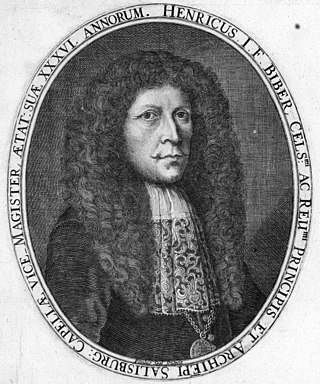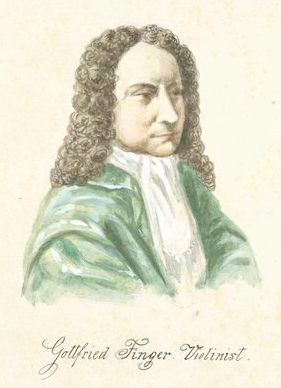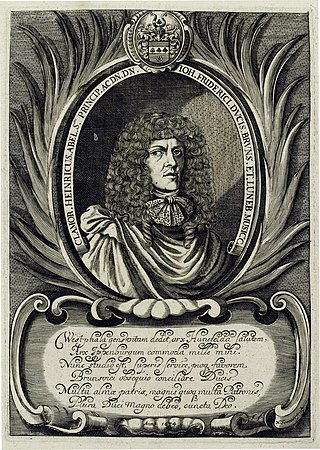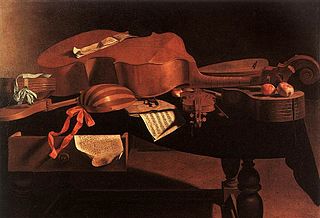Related Research Articles

Carl Friedrich Abel was a German composer of the pre-Classical era. He was a renowned player of the viola da gamba, and produced significant compositions for that instrument. He was director of music at the Dresden court from 1743, and moved to London in 1759, becoming chamber-musician to Queen Charlotte in 1764. He founded a subscription concert series there with Johann Christian Bach. According to the Catalogue of Works of Carl Friedrich Abel (AbelWV), he left 420 compositions, with a focus on chamber music.

A sackbut is an early form of the trombone used during the Renaissance and Baroque eras. A sackbut has the characteristic telescopic slide of a trombone, used to vary the length of the tube to change pitch, but is distinct from later trombones by its smaller, more cylindrically-proportioned bore, and its less-flared bell. Unlike the earlier slide trumpet from which it evolved, the sackbut possesses a U-shaped slide with two parallel sliding tubes, rather than just one.

The viola da gamba, or informally gamba, is any one of a family of bowed, fretted, and stringed instruments with hollow wooden bodies and pegboxes where the tension on the strings can be increased or decreased to adjust the pitch of each of the strings. Although treble, tenor and bass were most commonly used, viols came in different sizes, including pardessus, treble, alto, small tenor, tenor, bass and contrabass. Separating these from other bowed string instruments such as the viola da braccio was the instruments' orientation; members of the older viol family were played with the neck oriented upwards, the rounded bottom downwards to settle on the lap or between the knees.

The viola d'amore is a 7- or 6-stringed musical instrument with additional sympathetic strings used chiefly in the baroque period. It is played under the chin in the same manner as the violin.
The trio sonata is a genre, typically consisting of several movements, with two melody instruments and basso continuo. It originated in the early 17th century and was a favorite chamber ensemble combination in the Baroque era.

Heinrich Ignaz Franz Biber was a Bohemian-Austrian composer and violinist. Biber worked in Graz and Kroměříž before he illegally left his employer, Prince-Bishop Karl Liechtenstein-Kastelkorn, and settled in Salzburg. He remained there for the rest of his life, publishing much of his music but apparently seldom, if ever, giving concert tours.

Eugène-Auguste Ysaÿe was a Belgian virtuoso violinist, composer, and conductor. He was regarded as "The King of the Violin", or, as Nathan Milstein put it, the "tsar".
John Coprario, also known as Giovanni Coprario or Coperario, was an English composer, viol player and teacher.

William Lawes was an English composer and musician.

Gottfried Finger, also Godfrey Finger, was a Moravian Baroque composer. He was also a virtuoso on the viol, and many of his compositions were for the instrument. He also wrote operas. Finger was born in Olomouc, modern-day Czech Republic, and worked for the court of James II of England before becoming a freelance composer. The fact that Finger owned a copy of the musical score of the work Chelys by the Flemish composer Carolus Hacquart suggests that the two composers may have worked together in England.

In music, a trio is any of the following:
Pieter Hellendaal was a Dutch composer, organist and violinist.
Louis-Gabriel Guillemain was a French composer and violinist.

Bass violin is the modern term for various 16th- and 17th-century bass instruments of the violin family. They were the direct ancestor of the modern cello. Bass violins were usually somewhat larger than the modern cello, but tuned to the same nominal pitches or sometimes one step lower. Contemporaneous names for these instruments include "basso de viola da braccio," "basso da braccio," or the generic term "violone," which simply meant "large fiddle." The instrument differed from the violone of the viol, or "viola da gamba" family in that like the other violins it had at first three, and later usually four strings, as opposed to five, six, or seven strings, it was tuned in fifths, and it had no frets. With its F-holes and stylized C-bouts it also more closely resembled the viola da braccio.
Adam Drese was a German composer, kapellmeister, and bass viol player of the baroque period.
[Domenico] Giovanni Antonio Pandolfi [Mealli] was an Italian composer and violinist.

Clamor Heinrich Abel was a German composer, violone player and organist.

Baroque music refers to the period or dominant style of Western classical music composed from about 1600 to 1750. The Baroque style followed the Renaissance period, and was followed in turn by the Classical period after a short transition. The Baroque period is divided into three major phases: early, middle, and late. Overlapping in time, they are conventionally dated from 1580 to 1650, from 1630 to 1700, and from 1680 to 1750. Baroque music forms a major portion of the "classical music" canon, and is widely studied, performed, and listened to. The term "baroque" comes from the Portuguese word barroco, meaning "misshapen pearl". The works of Antonio Vivaldi, George Frideric Handel and Johann Sebastian Bach are considered the pinnacle of the Baroque period. Other key composers of the Baroque era include Claudio Monteverdi, Domenico Scarlatti, Alessandro Scarlatti, Alessandro Stradella, Tomaso Albinoni, Johann Pachelbel, Henry Purcell, Georg Philipp Telemann, Jean-Baptiste Lully, Jean-Philippe Rameau, Marc-Antoine Charpentier, Arcangelo Corelli, François Couperin, Johann Hermann Schein, Heinrich Schütz, Samuel Scheidt, Dieterich Buxtehude, Gaspar Sanz, José de Nebra, Antonio Soler, Carlos Seixas, Adam Jarzębski and others, with Giovanni Battista Pergolesi being the most prominent Baroque composer of sacred music.
William Young was an English viol player and composer of the Baroque era, who worked at the court of Ferdinand Charles, Archduke of Austria in Innsbruck. The sonatas which he published in 1653 were some of the earliest sonatas produced by an English composer.

Judith Davidoff was an American viol player, cellist, and performer on the medieval bowed instruments. She was considered the “Grande Dame of the viol”, "a master of the viola da gamba and other stringed instruments" and "a central part of the early-music scene." Her recorded performances reflect her wide range of repertoire and styles, including such works as Schoenberg's Verklaerte Nacht and 13th-century monody. She is responsible for the catalog of 20th- and 21st-century viol music.
References
- ↑ "LOC Authorities". Archived from the original on 14 July 2012. Retrieved 14 November 2011.
- 1 2 Phillips, Elizabeth V., ed. (1991). Henry Butler: Collected Works, with basso continuo realizations and commentary by Jack Ashworth. Madison, WI: A-R Editions. p. vii. ISBN 0-89579-263-X.
- ↑ Keates, Jonathan (1996). Purcell: A Biography. London: Random House. p. 93. ISBN 1-55553-287-X.
- ↑ Boyden, David D. (1965). The History of Violin Playing from its Origins to 1761. London: Oxford University Press. pp. 237–38. ISBN 978-0-19-816183-7.
- ↑ OCLC Reference to 1989 Recording 'Musick for Severall Friends' on Harmonia Mundi. OCLC 22585199.